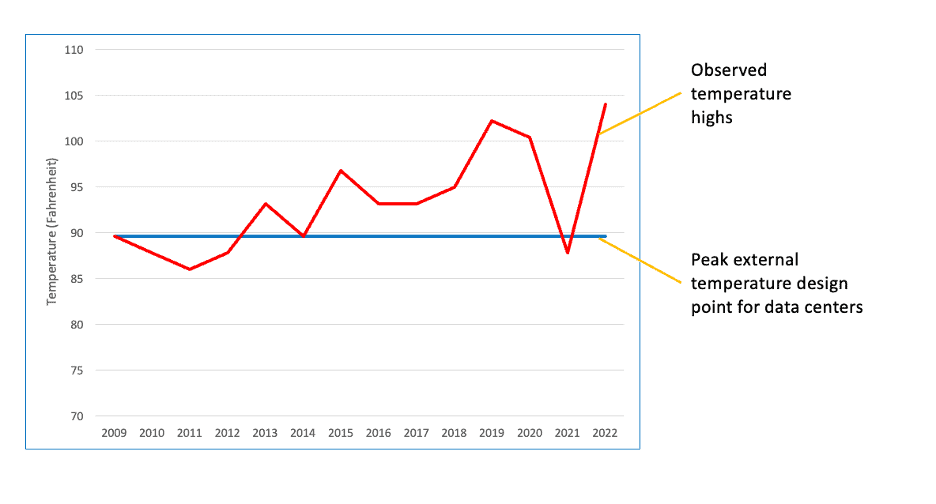
by
Praveen Asthana
If you don’t take steps to make your data center resilient to climate change, you may end up spending time on its roof hosing it down to keep it cool.
In the summer of 2022, cloud data centers belonging to Google and Oracle in London, U.K., suddenly went offline. This was not because of a network problem or a cybersecurity issue, but because it was simply too hot a day. The outdoor temperature had reached 105 o F, and the data centers’ cooling systems was unable to keep up. The data centers had to be shut down.
Most data centers in UK are designed to operate at a sustained peak outdoor temperature of 90 o F. And for many years, this was just fine as the outdoor temperature rarely exceed this level, and if it did, it was only by a degree or two. But, now, due to the effects of climate change, observed peak temperatures are frequently exceeding the design point and by a significant margin.

This is not just a UK phenomenon. All across the globe, data centers are seeing larger outdoor temperature excursions than they have been designed for in their local geography. Data center cooling stacks are under strain as they struggle to compensate for unexpectedly high outdoor temperatures.
And as the impacts of climate change deepen, high temperature excursions are expected to increase in intensity and frequency. If you are a data center operator or in the C-suite of a company in which data center down time can impact revenue, then you need to understand how climate change is impacting data centers and, more importantly, how to engineer resiliency.
Here’s what you need to watch out for:
- High temperatures stress the local electrical grid resulting in power instability that impacts data center operations. Data centers use a lot of power, around 2-3% of a country’s energy and local authorities have been known to ration power to data centers when the electrical grid is under strain.
- Water availability is impacted due to climate change induced drought. For many data centers, water is as important as power. Data center cooling systems rely on chilled water loops and evaporators.
What can you do to mitigate these issues?
One option is to increase the size of the cooling stack to be able to handle larger outdoor temperature excursions. This has two problems—the first is a budget hit, as cooling stack costs increase non-linearly with the capacity of the cooling system. The second is the considerable difficulty of retrofitting a larger cooling stack into an existing data center along with the impacts to downtime and budget.
Another option is to implement liquid cooling for the servers in the data center. This can be very efficient because cooling is focused on the specific elements that generate heat rather than the brute force method of using powerful, but unfocused, central air conditioning units that try to manage the temperature of the entire facility.
A particularly effective form of liquid cooling is direct to chip liquid cooling in which a fluid circulates through a type of heat sink known as a cold plate. This cold plate is in contact with the hot chips in a server and remove heat from those chips. This method provides significant thermal headroom for the servers—i.e. keeps the chips operating below their specified case temperature limits even for very powerful (> 1000 W) chipsets. The combination of focused cooling and thermal headroom enables direct to chip liquid cooling to operate independently of outdoor temperatures, and thus provides protection from climate change induced temperature excursions.
Direct to chip liquid cooling also reduces the need for facility power since much less is required for cooling (typically as much as 40% of data center energy usage goes towards cooling, but with liquid cooling implemented, this can be reduced to 10%). With reduced power needs, data centers are more easily able to handle interruptions in grid power or rationing of grid power.
A very significant benefit of using direct to chip liquid cooling is that it is easy to retrofit into an existing data center, in contrast with trying to upgrade the entire central air conditioning cooling stack.
Implementing liquid cooling, in addition to providing resiliency against climate change, can also help provide resiliency against government regulators. For example, the EU has introduced a corporate sustainability reporting requirement which requires large companies to disclose their exposure to climate change risks and the US SEC is considering a similar set of rules
And by the way, the hosing of data center roof tops, it actually happened in UK during the heatwave (https://www.datacenterknowledge.com/sustainability/hosepipes-roofs-are- keeping-uk-s-data-centers-cool). It’s just not a very effective or practical solution!